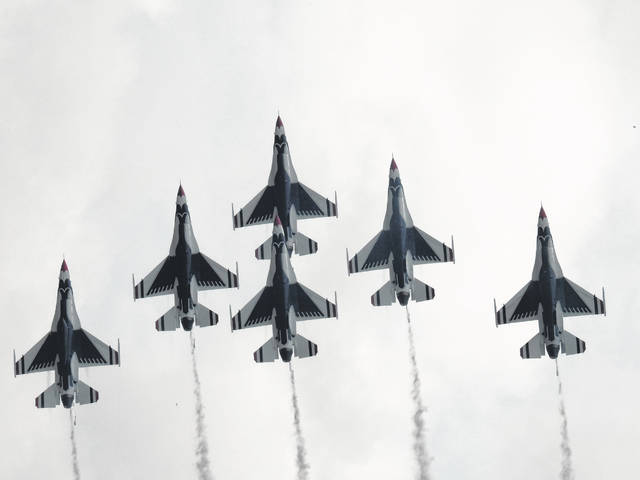
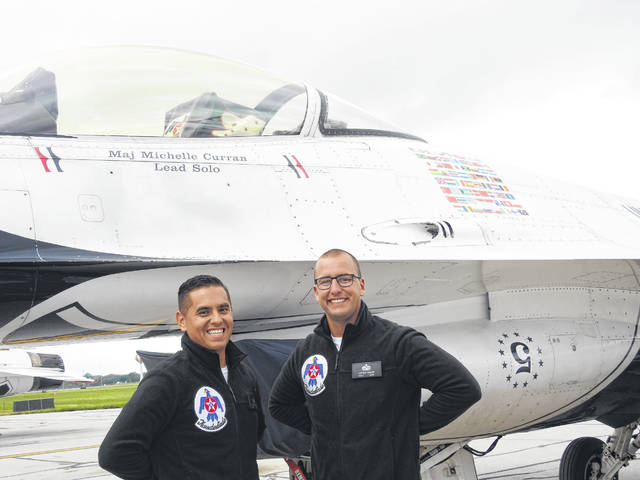
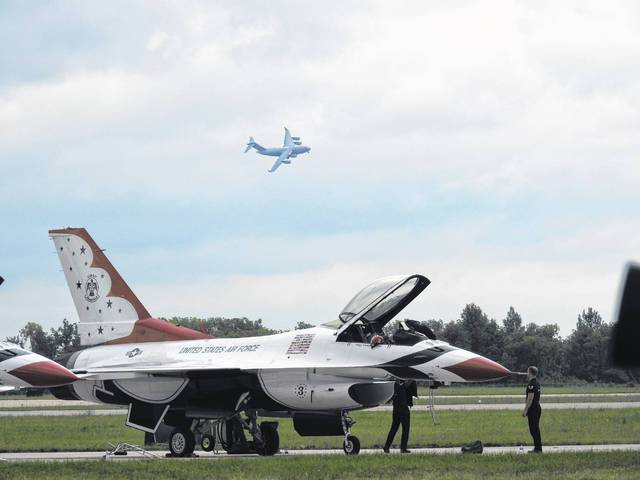
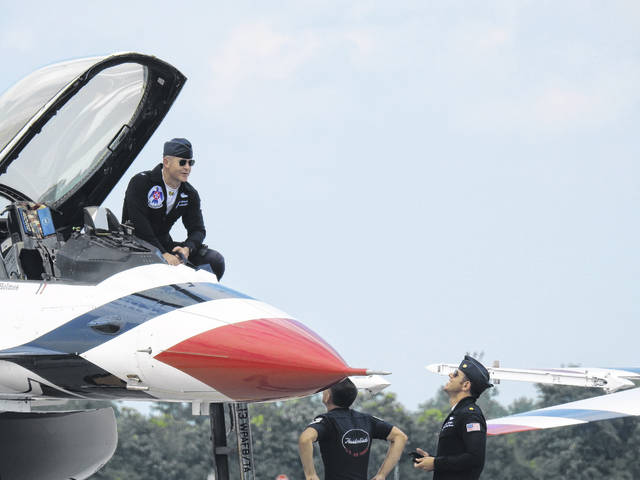
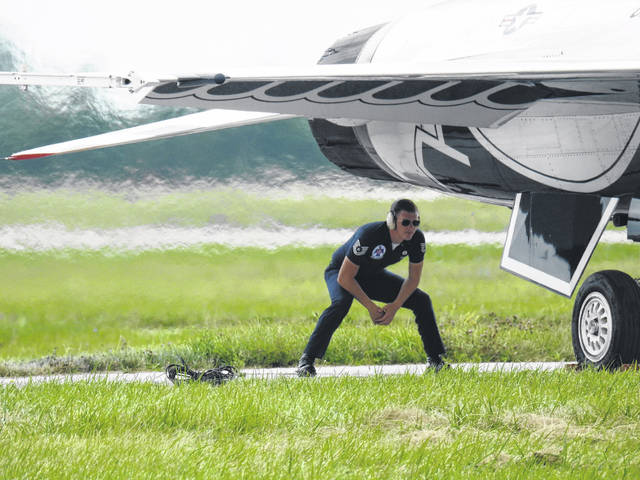
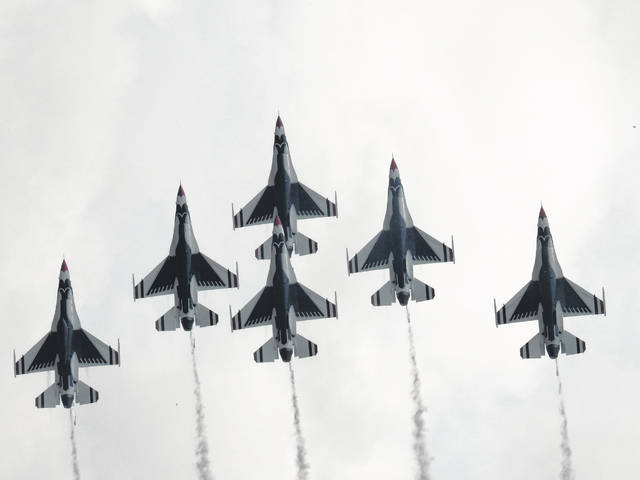
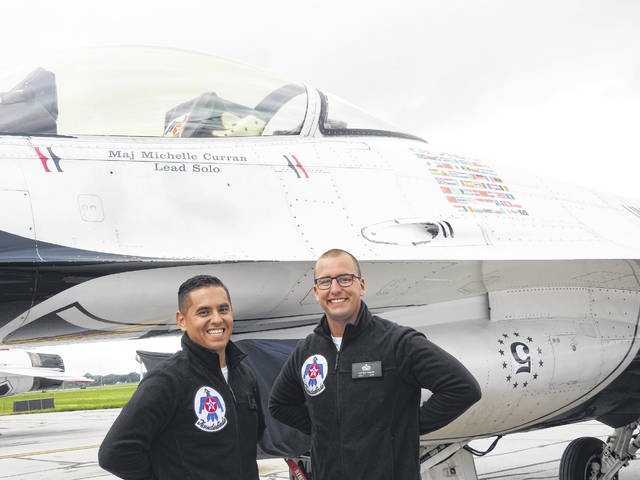
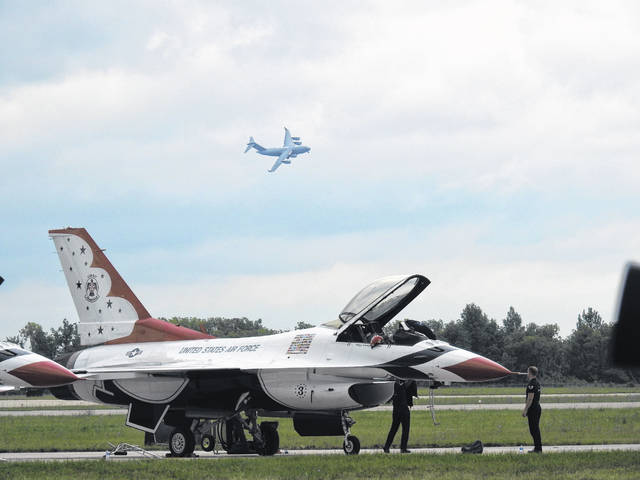
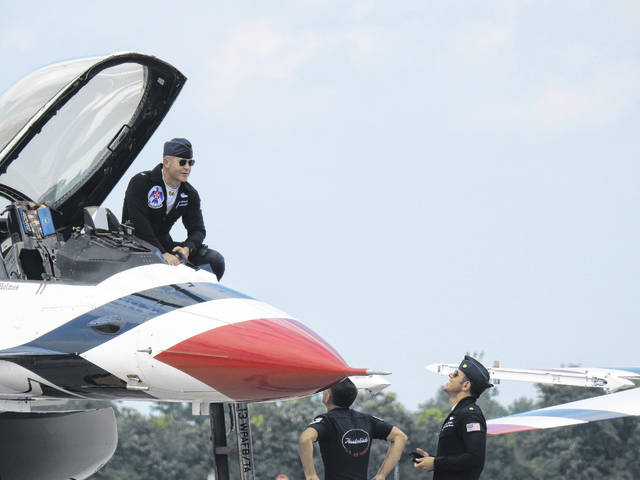
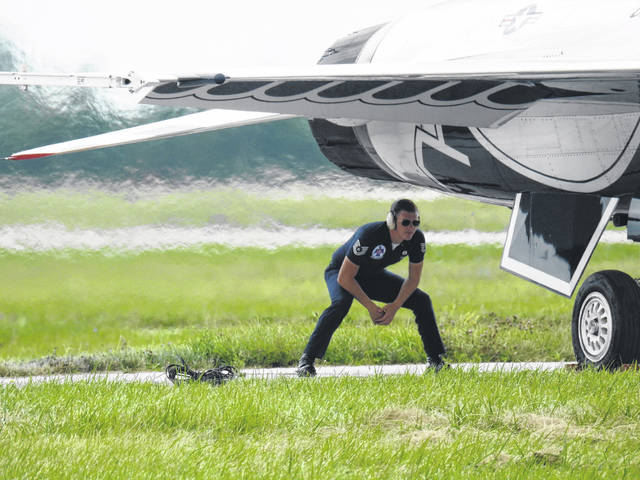
DAYTON — We all know it’s the pilots who get the love at air shows but this year, at the Center Point Dayton Air Show, we were able to talk to SSGT Xavier Knapp of Kalamazoo, Michigan, and SSGT Nicholas Martinez of Fresno, California, crew chiefs for our US Air Force Thunderbirds.
It was a rainy, low ceiling kind of day and Martinez, whose specialty is tactical aircraft maintenance, joked that they prefer to work indoors, that the jets don’t really like the water, though at least we don’t have salt water to aid corrosion. Martinez’ plane, belongs to the Boss, Col John Caldwell, Commander/Leader. Knapp is dedicated to the Slot, #4, belonging to Major Michael Brewer.
The United States Thunderbird demo team came into being May 25, 1953, as a recruiting tool for the Air Force, and to allow the general public a peek into the Air Force capabilities. The lineup of the aircraft is: F-84G Thunderjet, F-84F Thunderstreak, F-100 Super Sabre, F-105 Thunderchief, F-4 Phantom II, T-38 Talon and finally, the F-16 Fighting Falcon, entering the fleet in 1983.
Knapp shared an interesting fact that the T-38 replaced the popular F-4 Phantom because during the gas crisis of President Ford’s administration it would take four T-38’s to take up versus one F-4, so the economical decision was to change aircraft.
Not to play favorites or anything, but how is the F-16 superior to say, the F-15 or F-18?
“The F-15 is more air-to-air, so it’s not as nimble and agile as the F-16,” Martinez nods to the jet next to him. “We can do air-to-ground, air-to-air; anything it needs to do in combat. It has a lot more capabilities. The F-15 from what I’ve heard, is good at what it does, but the F-16 is the best, in my opinion.”
Knapp jumps in. “As far as the F-18 is concerned, when they were in competition with the F-16 for the Air Force’s new fighter jet,” -allow me to interrupt; speaking of competition, an air show is unfolding in the low ceiling skies above us and another Thunderbird jet is slowly being taxied behind the crew chiefs, but despite the distractions, THIS is a fun way to interview. I digress…”it was actually the F-18 and the F-16, and the Air Force ended up picking the F-16, so the Navy actually got the F-18. But there are a couple of Navy units that have the F-16 in their fleet as well, as training.”
Worst case scenario, if necessary these Thunderbirds could be made combat ready in 72 hours. Martinez gestures to the current demo jet, “So we remove our gun drum and all the gun components, and a few avionics packages because they’re obsolete for our use.”
The F-16 is capable of flying Mach 2, and can pull 9.2 G’s. “It’s a super agile, multi roll fighter,” Knapp interjected. “In Desert Storm, it was really good for Wild Weasel, which was going into SAM missile sites on the ground, taking out SAM sites in Iraq and Afghanistan, it was really good for that.”
Every jet has a crew chief and specialists, who can help with avionics (electronics), sheet metal, anything the fighter/demo needs. “Once they land, ” Martinez shares, “they give a squawk code, 1-2-3. 1 means everything ‘s good with the jet, just needs normal servicing and whatnot. Code 2 means it can fly again but it needs to be looked at, and code 3 means something’s broke.” They have to check everything, engines, landing gear, flight controls, hydraulic systems, you name it, they meticulously inspect it after each flight.
What’s the best part of their jobs? Martinez; “It’s honestly the engagement is what I love the most,” and Knapp nods agreement. “Little kids coming up and just lighting up when they see the jet; it’s really cool. It’s different from our every day Air Force lives.”
Knapp enthused, “And the relationships we form here on the Thunderbirds team, we’re a really small unit. You normally don’t get the interaction with your pilot like you do here. The number 4 pilot [Major Michael Brewer] and I see each other all the time, and we’re on the road two hundred and some odd days a year.”
Maintenance crew members do get one flight with their jet and pilot as a way to better understand their charges. Their brakes usually last a year, and tires typically get changed out around every month. The support staff will follow the team to shows with everything necessary to perform their jobs; spare motors, spare parts-pretty much everything they could need on the road, via the C-17.
If you’re watching the crew interact with the pilots at the shows you’ll notice the different launches the crew provides for the send off. Synchronized and precise, the crew chiefs send off their pilots with the latter having specialized “gang signs” as a tradition.
While spectators get to experience the final, perfect show, Knapp reminds us that while we see the 12 people out on the field doing the performance, “There are so many other professionals on second shift, on swing shift, at home doing heavy maintenance back there. There are more unsung heroes out there. It’s such a huge team effort, it’s absolutely insane. Those guys deserve the equal amount of praise.”
The next time you catch the Thunderbird demo at an air show, give a wave and nod of appreciation to the crew chiefs who help make the magic happen. Special thanks to SSGT Xavier Knapp, SSGT Nicholas Martinez, and the wonderfully kind photojournalist MSgt Veronica Montes, and Public Affairs Officer Capt Kaity Toner, United States Air Force Thunderbirds, 2021.






